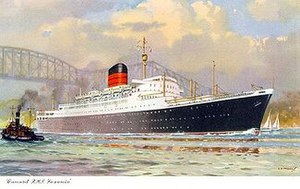RMS Saxonia (1954)
 Postcard of RMS Saxonia
| |
| History | |
|---|---|
| Name |
|
| Owner |
|
| Operator |
|
| Port of registry |
|
| Builder | |
| Yard number | 692[1] |
| Launched | 17 February 1954[1] |
| Completed | August 1954[1] |
| Maiden voyage | 2 September 1954[1] |
| Out of service | 6 October 1995[1] |
| Identification |
|
| Fate | Scrapped in Alang, India in 1999.[1] |
| General characteristics (as built, 1954)[2] | |
| Class and type | Saxonia class ocean liner |
| Tonnage | |
| Length | 608 ft (185 m) |
| Beam | 80 ft (24 m) |
| Draught | 28 ft (8.5 m)[1] |
| Installed power | 24,500shp |
| Propulsion | Geared turbines from builders, Twin screw |
| Speed | 20 knots (37.04 km/h; 23.02 mph) |
| Capacity | 125 first class, 800 tourist class |
| Crew | 461 |
| General characteristics (as rebuilt, 1963)[1] Ship type=Ocean liner/cruise ship | |
| Tonnage | 22,592 GRT (1969, 21,370 GRT) |
| Capacity | 117 1st class, 764 tourist class |
| Notes | Otherwise the same as built |
RMS Saxonia was a British
History

Prior to World War II, Cunard's Canadian services had been maintained by a group of six similar 14,000 GRT liners of the Andania class built between 1922 and 1925. One of these was a war loss and another four were purchased by the Admiralty during the war and converted to naval repair ships. None of these ever returned to commercial service. This left Cunard with one ship, Ascania from its pre war Canadian fleet. She was joined in the post war service by three of the surviving units of the 20,000 GRT Scythia class which had been built for the Liverpool-New York service. Of the four, only Ascania was able to reach Montreal, draught causing the others to turn around at Quebec. With this unsatisfactory situation and the age of the ships, it was inevitable that the decision to build would be taken and at the end of 1951 Cunard announced its intention to order two new ships for the Canadian service (the other two came later). Saxonia was launched on 17 February 1954 by Lady Churchill, wife of the then Prime Minister, and revived a name previously used for the Cunard liner

In 1968, the ship had a major breakdown at the mouth of the

She was laid up at
References
- ^ a b c d e f g h i j k l m Asklander, Micke. "S/S Saxonia (1954)". Fakta om Fartyg (in Swedish). Retrieved 21 November 2008.
- ^ ISBN 0-486-28137-X.
- ^ "News in Brief". News in Brief. The Times. No. 53027. London. 3 September 1954. col G, p. 2.
- ^ The Glasgow Herald - 13 May 1969 Liner in collision with Soviet ship
- ^ Edwards, Lorna (1 January 2010). "Bikini girl who made a splash". The Sydney Morning Herald. Retrieved 28 December 2013.
